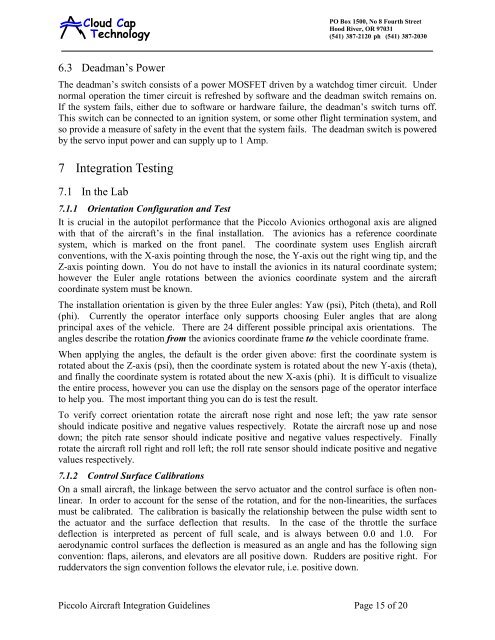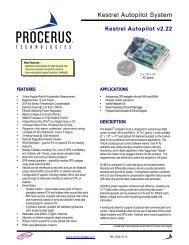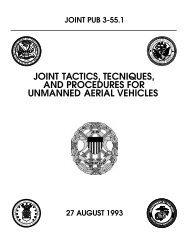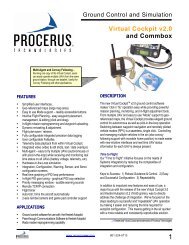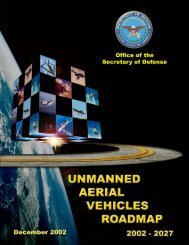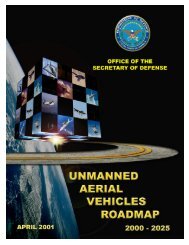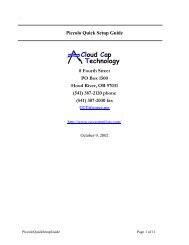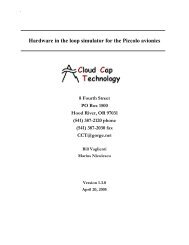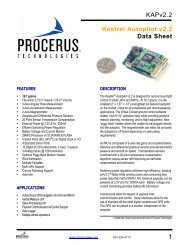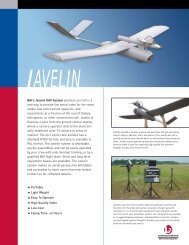Technology Cloud Cap - Unmanned Aircraft & Drones
Technology Cloud Cap - Unmanned Aircraft & Drones
Technology Cloud Cap - Unmanned Aircraft & Drones
You also want an ePaper? Increase the reach of your titles
YUMPU automatically turns print PDFs into web optimized ePapers that Google loves.
<strong>Cloud</strong> <strong>Cap</strong><strong>Technology</strong>PO Box 1500, No 8 Fourth StreetHood River, OR 97031(541) 387-2120 ph (541) 387-2030fax6.3 Deadman’s PowerThe deadman’s switch consists of a power MOSFET driven by a watchdog timer circuit. Undernormal operation the timer circuit is refreshed by software and the deadman switch remains on.If the system fails, either due to software or hardware failure, the deadman’s switch turns off.This switch can be connected to an ignition system, or some other flight termination system, andso provide a measure of safety in the event that the system fails. The deadman switch is poweredby the servo input power and can supply up to 1 Amp.7 Integration Testing7.1 In the Lab7.1.1 Orientation Configuration and TestIt is crucial in the autopilot performance that the Piccolo Avionics orthogonal axis are alignedwith that of the aircraft’s in the final installation. The avionics has a reference coordinatesystem, which is marked on the front panel. The coordinate system uses English aircraftconventions, with the X-axis pointing through the nose, the Y-axis out the right wing tip, and theZ-axis pointing down. You do not have to install the avionics in its natural coordinate system;however the Euler angle rotations between the avionics coordinate system and the aircraftcoordinate system must be known.The installation orientation is given by the three Euler angles: Yaw (psi), Pitch (theta), and Roll(phi). Currently the operator interface only supports choosing Euler angles that are alongprincipal axes of the vehicle. There are 24 different possible principal axis orientations. Theangles describe the rotation from the avionics coordinate frame to the vehicle coordinate frame.When applying the angles, the default is the order given above: first the coordinate system isrotated about the Z-axis (psi), then the coordinate system is rotated about the new Y-axis (theta),and finally the coordinate system is rotated about the new X-axis (phi). It is difficult to visualizethe entire process, however you can use the display on the sensors page of the operator interfaceto help you. The most important thing you can do is test the result.To verify correct orientation rotate the aircraft nose right and nose left; the yaw rate sensorshould indicate positive and negative values respectively. Rotate the aircraft nose up and nosedown; the pitch rate sensor should indicate positive and negative values respectively. Finallyrotate the aircraft roll right and roll left; the roll rate sensor should indicate positive and negativevalues respectively.7.1.2 Control Surface CalibrationsOn a small aircraft, the linkage between the servo actuator and the control surface is often nonlinear.In order to account for the sense of the rotation, and for the non-linearities, the surfacesmust be calibrated. The calibration is basically the relationship between the pulse width sent tothe actuator and the surface deflection that results. In the case of the throttle the surfacedeflection is interpreted as percent of full scale, and is always between 0.0 and 1.0. Foraerodynamic control surfaces the deflection is measured as an angle and has the following signconvention: flaps, ailerons, and elevators are all positive down. Rudders are positive right. Forruddervators the sign convention follows the elevator rule, i.e. positive down.Piccolo <strong>Aircraft</strong> Integration Guidelines Page 15 of 20


